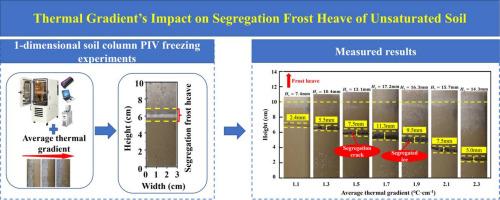Thermal Gradient's Impact on Segregation Frost Heave of Unsaturated Soil
IF 3.8
2区 工程技术
Q1 ENGINEERING, CIVIL
引用次数: 0
Abstract
The thermal gradient is a key factor that causes and affects water migration and frost heave deformation (referred to as partial frost heave) of soil in cold regions. To investigate the influence of thermal gradient on the freezing behavior of soil in cold regions, this study used a self-developed experimental device to observe the freezing process of unsaturated soil columns with water supply under different average thermal gradients (ATGs). The deformation field of the soil freezing process was obtained using PIV technology, and the influence of thermal gradient on the migration of unsaturated soil moisture and the freezing deformation process was analyzed. The test results demonstrate the following: (1) The maximum frost heave (17.2 mm), total water uptake (270 ml), segregation crack width (11.3 mm), and peak strain (1.43) occur at the critical ATG of 1.7 °C∙cm−1. (2) The thermal gradient within the frozen fringe (TGFF), but not the ATG, affects water migration, peaking at 1.1 °C·cm−1 (critical ATG) and being correlated linearly with the frost heave amount (). (3) Our model (R2 = 0.97) enables the accurate prediction of the water migration rate (with a < 7 % error), providing a new method for analyzing frost heave mitigation in engineering projects. A value below the critical ATG (e.g., thermal insulation at 1.7 °C·cm−1) minimizes frost damage in cold-region infrastructure. These findings reveal the effect of the critical ATG on frost heave, ensuring the prevention or control of frost heave in cold region engineering projects.

热梯度对非饱和土分离冻胀的影响
热梯度是寒区土壤水分迁移和局部冻胀变形的重要原因和影响因素。为了研究热梯度对寒冷地区土壤冻结行为的影响,本研究利用自行研制的实验装置,观察了不同平均热梯度(ATGs)条件下非饱和土柱在供水条件下的冻结过程。利用PIV技术获得了土体冻结过程的变形场,分析了热梯度对非饱和土体水分迁移和冻结变形过程的影响。试验结果表明:(1)在临界ATG为1.7℃∙cm−1时,最大冻胀量(17.2 mm)、总吸水量(270 ml)、偏析裂缝宽度(11.3 mm)和峰值应变(1.43)出现。(2)影响水迁移的是冻结条纹(TGFF)内的热梯度,而不是ATG,在1.1°C·cm−1(临界ATG)处达到峰值,且与冻胀量呈线性相关(Hv=12.36×TGFF+4.12)。(3)我们的模型V0=1.85×10−10×TGFF (R2 = 0.97)能够准确预测水迁移速率(误差<; 7%),为分析工程项目的霜胀缓解提供了一种新的方法。低于临界ATG的值(例如,隔热温度为1.7°C·cm - 1)可以最大限度地减少寒冷地区基础设施的霜冻损害。研究结果揭示了临界ATG对冻胀的影响,为寒区工程冻胀的防治提供了依据。
本文章由计算机程序翻译,如有差异,请以英文原文为准。
求助全文
约1分钟内获得全文
求助全文
来源期刊

Cold Regions Science and Technology
工程技术-地球科学综合
CiteScore
7.40
自引率
12.20%
发文量
209
审稿时长
4.9 months
期刊介绍:
Cold Regions Science and Technology is an international journal dealing with the science and technical problems of cold environments in both the polar regions and more temperate locations. It includes fundamental aspects of cryospheric sciences which have applications for cold regions problems as well as engineering topics which relate to the cryosphere.
Emphasis is given to applied science with broad coverage of the physical and mechanical aspects of ice (including glaciers and sea ice), snow and snow avalanches, ice-water systems, ice-bonded soils and permafrost.
Relevant aspects of Earth science, materials science, offshore and river ice engineering are also of primary interest. These include icing of ships and structures as well as trafficability in cold environments. Technological advances for cold regions in research, development, and engineering practice are relevant to the journal. Theoretical papers must include a detailed discussion of the potential application of the theory to address cold regions problems. The journal serves a wide range of specialists, providing a medium for interdisciplinary communication and a convenient source of reference.
 求助内容:
求助内容: 应助结果提醒方式:
应助结果提醒方式:


